 When measuring EMI performance, did you find that whatever the filtering method you used, there was still a few dB out of specification? There is a way to help you meet EMI performance requirements or simplify your filter design. This method involves modulation of the power switching frequency to introduce sideband energy and change the narrowband noise to broadband emission characteristics, thereby effectively attenuating harmonic peaks. It should be noted that the overall EMI performance has not been reduced but has only been redistributed.
When measuring EMI performance, did you find that whatever the filtering method you used, there was still a few dB out of specification? There is a way to help you meet EMI performance requirements or simplify your filter design. This method involves modulation of the power switching frequency to introduce sideband energy and change the narrowband noise to broadband emission characteristics, thereby effectively attenuating harmonic peaks. It should be noted that the overall EMI performance has not been reduced but has only been redistributed. With sinusoidal modulation, the two variables of the controllable variable are the modulation frequency (fm) and the amplitude at which you change the power switching frequency (Δf). The modulation index (Β) is the ratio of these two variables. When Β=0, there is no frequency shift and there is only one spectral line. When Β=1, the frequency characteristic starts to extend and the center frequency component drops by 20%. When Β=2, this feature will be further extended and the maximum frequency component is 60% of the initial state. Frequency modulation theory can be used to quantify the amount of energy in the spectrum. The Carson's law states that most of the energy will be contained in the 2*(Δf+fm) bandwidth.
Selecting modulation frequency and frequency shift are two very important aspects. First, the modulation frequency should be higher than the EMI receiver bandwidth so that the receiver does not measure both sidebands at the same time.
However, if you choose too high a frequency, the power control loop may not be able to fully control this change, resulting in an output voltage change at the same rate. In addition, this modulation can also cause audible noise in the power supply. Therefore, the modulation frequency we choose generally cannot exceed the receiver bandwidth too much, but must be greater than the audible noise range.
It is preferable to change the operating frequency greatly. However, this will affect the power supply design and it is important to realize this. That is, select the magnetic element for the lowest operating frequency. In addition, the output capacitor also needs to handle larger ripple currents due to lower frequency operation.
A comparison of EMI performance measurements with and without frequency modulation was performed. The modulation index at this time is 4, and as expected, the EMI performance at the fundamental frequency is reduced by approximately 8 dB. Other aspects are also important. The harmonics are smeared into the frequency band corresponding to their number, ie the third harmonic is extended to three times the fundamental frequency. This situation is repeated at some higher frequencies, making the noise floor much higher than the fixed frequency. Therefore, this method may not be suitable for low noise systems. However, many systems have benefited from this approach by increasing design margins and minimizing EMI filter costs.
10.1 Inch Laptop,win10 Laptops,win11 Laptops
Jingjiang Gisen Technology Co.,Ltd , https://www.gisentech.com